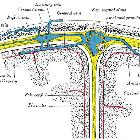Arachnoid mater

The arachnoid mater forms the middle layer of the meninges and together with the pia mater is sometimes referred to as the leptomeninges.
Gross anatomy
The arachnoid mater is a membrane that comes into direct contact with the dura mater and is separated from the pia mater by a CSF-filled space known as the subarachnoid space .
The arachnoid mater loosely surrounds the entire brain and is easily separable from the dura except where it is adherent to the adventitia of the internal carotid and vertebral arteries at the point in which they enter the subarachnoid space . It extends to the superior surface of the pituitary fossa but does not envelop the pituitary gland itself. At the level of the foramen magnum, the cerebral arachnoid mater is continuous with the spinal arachnoid mater. The arachnoid mater also exits the cranium as part of the optic nerve-sheath complex .
It does not enter the sulci or fissures except at the great longitudinal fissure between the cerebral hemispheres. It is loosely associated with the pia mater via a network of connective tissue that crosses the subarachnoid space known as arachnoid trabeculae, arachnoid septae and arachnoid membranes (some of which are named) .
Outpouchings of the arachnoid mater that pierce the dura in the venous dural sinuses are known as arachnoid granulations and are involved in CSF reabsorption .
History and etymology
The term arachnoid is derived from the Greek word "arachne" meaning "spider" on account of the delicate web-like appearance of the arachnoid membranes, trabeculae and septae that traverse the subarachnoid space from the arachnoid mater to the pia mater.
Related pathology

